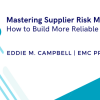Throughout the course of my career, I’ve had the pleasure of working through more than one organizational downturn – whether due to the economy or the company’s financial status. In times like this, the organization turns to supply chain to lead and impact the bottom line.
In the name of “Transformation” or “Cost Reduction Initiative” the idea is to deliver results to the business quickly. In an environment where you are reporting your progress weekly or sometimes daily, it is so easy to take a short-term view or highly transactional approach to how you manage projects in your category.
I will use my experience with an oil and gas firm during the most recent downturn. Volumes were down and the pressure to reduce cost from our customers was at an all-time high. Organizational leadership demanded 25% reductions from the supply base. In conversation with suppliers, I commonly received the response, “If I give you this reduction now, that will become the new baseline and we’ll never get a chance to recover it.” Hard to argue with that statement. After a few tough discussions, I determined it was time to take a step back and operate from at least a 10,000-foot view.
Knowing that this situation is real but most likely temporary, I had to develop a strategy that gave us enough leverage to meet the needs of the business without blowing up all the plans to deliver long-term value for the category. Likely you will need to utilize multiple methodologies to achieve results, but some things I contemplated included the following:
- Consider what things can be done without a direct impact to supplier profitability. Manage volume and overall spend by establishing business engagement guidelines, spend limits and approvals. Put the impetus back on the business to think through and justify their spending.
- Be transparent with the supply base. In times of crisis, there is little time to be coy. You have to be focused on the most effective way to achieve results. That means giving them a target and a timeframe. Help them understand their status with the organization. I am in the midst of using that approach right now with a client on a transformation initiative and I have rarely seen such quick responses and engagement.
- Lean into your supplier partners who are a part of critical areas of spend and familiar with your organization. We engage external suppliers because they are the experts in the product/service they provide. They have a greater view into best practices across companies and industries. Give them a chance to bring that expertise to you with creative strategies and approaches to meet your objectives.
- Think about how to incent the supply base to improve pricing through competition and strategic sourcing. The classic plays of consolidating volume, introducing competition outside of incumbents, RF(x)’s and direct negotiations still work in the right situation.
- Rationalize your suppliers to optimize results. I have used the following guidelines to evaluate and moderate my supply base for services. In a highly competitive market and volatile industry, a solid performance is not enough. They must meet and exceed with both qualitative and quantitative measures to stay on the team.
- Number of active projects. A key indicator of how well a supplier performs is the number of active projects with the business. If you’re not actively working with our organization, there isn’t a need.
- Forecasted demand for new projects and requisitions. We reviewed activity for the last two quarters and checked in with the business about future needs. If there were 10 new projects that were distributed to 20 suppliers, this does not motivate our suppliers to provide competitive and creative proposals. We have to right size the supply base to fit the anticipated needs of the business.
- Response to cost reduction initiatives. How does the supplier respond to supply chain cost reduction request? Do they make a good faith effort and take a creative approach to reducing cost?
- Ease of doing business. Do they display a generally positive attitude about working with our company? Have they accepted our preferred contract terms and conditions?
- Performance in relation to peers. I think this is pretty self-explanatory.
It is my responsibility as a professional to NOT press the panic button in times of crisis...to act with urgency but not with recklessness. Supply chain professionals are charged to look at the bigger picture for the category and engage our supply base in a strategic fashion that yields a superior return for the organization.









